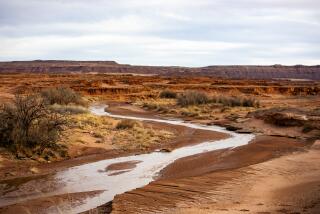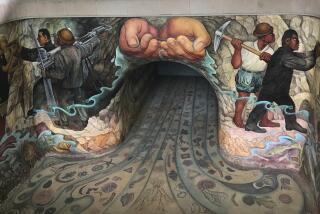New Delhiâs Insatiable Thirst a Drain on India
NEW DELHI â Rising high above the shanties of Rahul Gandhi Camp, a water tower painted white with red stripes stands as a concrete monument to comforts that the slum dwellers canât have.
Water in the tower is reserved for Indian Airlines staff and their families, who overlook the shanties from an apartment complex on the other side of a tall wall topped with tangled coils of barbed wire.
Squatters in Rahul Gandhi Camp siphon their water daily from a tanker truck in a frantic roadside ritual of survival.
About 2,000 people live in the slum, which was built illegally on government land 20 years ago. They earn their wages in surrounding wealthy neighborhoods by cleaning floors, guarding gates, tending gardens, laying bricks and baby-sitting children.
Those who work close enough and get a break at the right time go home to wait for the water truck in the afternoon heat that regularly climbs above 110 degrees. But water duty usually falls to elderly women, wives and children.
The shout goes up each day when the tankerâs dust trail is spotted in the distance.
The slum residents come running, juggling long siphon hoses, old plastic jerrycans, paint tins, plastic bags and buckets. The water often runs out before everybody has their share, and then the fists are up and the real fight for clean water is on.
Around the world, in rich countries and poor, the search for clean water is becoming increasingly desperate.
With about 14 million residents, New Delhi has suffered a water shortage for several years. Its struggle to cope is a warning of what can happen when the well runs dry.
After a brawl over water left four people injured in late April, New Delhi police began keeping careful watch over about 25 neighborhoods where they think trouble could erupt over water and power shortages.
The government is feeling the pressure to solve the water crisis, but some of the solutions are fraught with more danger.
India is a developing country of more than 1 billion people. New Delhi, as the capital, is a âpampered placeâ because it has the power to shift resources from neighboring regions, water expert Manu Bhatnagar said. Thatâs risky, he added.
Treated water from the Yamuna River, which is so polluted with sewage and industrial waste that itâs known as New Delhiâs sewer, provides most of the supply pumped to millions of homes or delivered to the poor in tankers. The rest comes from private wells, many of which are running dry, or from neighboring Indian states.
Cheap, clean water is considered a basic right by many Indians, and New Delhiâs water authority charges homeowners just over 15 cents for about 260 gallons. The poor get it free. With the cost of wasting water so low, the city must keep reaching farther to quench an insatiable thirst.
âNew Delhi is sucking up natural resources from a very vast area,â Bhatnagar said. âObviously, we are depriving other areas of their natural resources.
âIt is possible that in the future, if we have a prolonged drought, we could have political problems with the other provinces from where these resources are being drawn,â he added. âThey could disrupt pipelines. They could take to the streets.â
Bhatnagarâs eyes light up when he remembers the bounty of 1964, when New Delhi was a smaller, poorer place -- yet so rich in groundwater that it was bubbling up into basements.
Decades of development have turned that surplus into deficit. More flush toilets and showers, more cars to wash and concrete to stop rainwater from regenerating depleted wells, more irrigation to keep cash crops alive, more expansive suburban lawns and gardens to water -- all drive up the demand for water.
By some estimates, there are about 400,000 wells of different sorts in New Delhi. When the water shortage is most acute, during the weeks just before the summer monsoon rains, usually in late June, the pressure on water supplies is overwhelming.
âWe are extracting the water in an unsustainable manner,â said Bhatnagar, an advisor on water issues to the nongovernmental Indian National Trust for Art and Cultural Heritage. âAlmost every year, a number of wells are having to be abandoned because of dwindling yields or deteriorating water quality.â
New Delhiâs water table has dropped more than 75 feet since the 1960s, he added, and some wells that ran dry at 150 feet have been dropped to twice that depth in the last few years.
Since 1998, the cityâs water authority, the Delhi Jal Board, has been responsible for getting fresh water to the capitalâs people and treating the wastewater they produce.
The water board is able to supply only about 80% of the cityâs daily need.
The gap is filled, in large part, by groundwater pumped from private wells, many of which are illegal. Excessive use of groundwater, by the rich and the poor, is drying up aquifers, dropping the water table and, in many cases, forcing people to tap brackish, or salty, water that sits just below the fresh water.
More than 400,000 squatters live in New Delhiâs many slums. For those without wells or illegal taps into the water mains, tanker trucks are the main source of clean water.
The water board dispatches up to 1,050 tankers each day, supplying more than 100,000 homes with free water, said P.K. Tripathi, the boardâs chief executive officer.
The water trucks donât keep tight schedules, so those who depend on them spend a lot of time waiting.
Deepa Islam, 35, is a nanny to children of the rich living in the Vasant Vihar district. She earns about $32 a month working eight hours a day, six days a week.
During her afternoon breaks, she walks back to the slum and waits for the tanker to come. Sometimes she sits for two hours, and at least once a week she gets no water because she misses the truck or it runs dry before she gets her share.
Islam lives with her 13-year-old daughter in a one-room house made of bricks held together by dried mud. The only light is from a few narrow shafts of sun that break through gaps between the walls and the low ceiling of bamboo poles and black plastic tarp.
In May and June, itâs like living in a clay oven. It is not a place to be without clean water.
She and her neighbors used to get fresh water from a well using a hand pump. City authorities cut it off to pressure the shanty dwellers to take an offer of land 25 miles away and leave, resident Pramode Kumar Das said.
Bulldozers moved in and demolished many of the shanties April 28, reducing much of the slum to rubble.
But the community, named after the son of assassinated Prime Minister Rajiv Gandhi, a champion of the poor, wonât die quietly.
There is no shortage of masons among Islamâs neighbors, so the homes were quickly rebuilt. The water board kept sending tankers.
The wealthy of Vasant Vihar continue to gripe about the eyesore in their midst, yet still are happy to use the cheap labor.
âWe have no solutions to our problems,â Islam said. âNo one cares about our welfare. They just extract our labor.â
New Delhiâs government thinks that it has a big fix for the cityâs enormous demand for water: an extra 140 million gallons a day flowing from the new Tehri Dam on the Bhagirathi River, in the Himalayas about 200 miles northeast of the capital.
Tehri Dam, the worldâs fifth highest at just over 850 feet, cost at least $1.2 billion to build. It was beset by corruption charges and protests but is expected to be finished this year. It will create a narrow reservoir more than 2 miles long and 80 feet deep.
Powerful earthquakes are common in the Himalayan region. While the builders say Tehri Dam can withstand a quake of up to magnitude 7.2, independent experts have warned that even stronger quakes are possible in the region. Bhatnagar said there are fears that the sheer weight of the new lake, about 4 billion tons of water, could trigger an earthquake.
Seismologists have suspected for many years that dam reservoirs can affect fault lines. A 1982 report in the journal California Geology cited four known cases of earthquakes measuring at least magnitude 5.7 that were triggered by dams in India, China, southern Africa and Greece.
The new water supply, a drive for more conservation and repairs to leaky pipes are likely to put off the next water crisis for only 10 years, said Tripathi, the water board chief.
Tripathi wants to triple prices next year, after Novemberâs elections for the capitalâs government, when politicians think the heat will be off.
âI donât want a 10% increase,â Tripathi said. âIt doesnât serve any purpose. People are willing to pay. The problem is politicians arenât willing to charge.â
More to Read
Sign up for Essential California
The most important California stories and recommendations in your inbox every morning.
You may occasionally receive promotional content from the Los Angeles Times.










